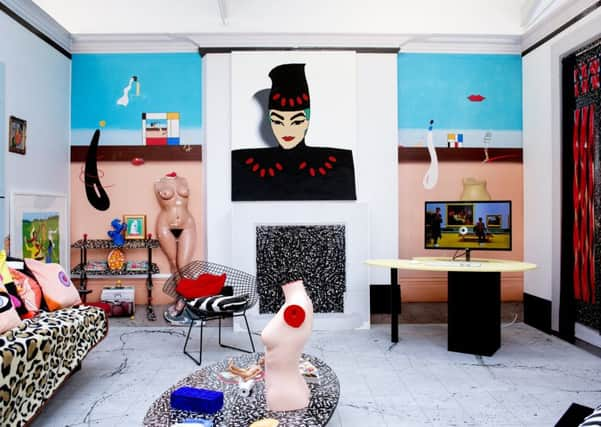Art review: Glasgow International - Torsten Lauschmann, Ross Birrell, James Pfaff, Ciara Phillips, Duggie Fields, Corin Sworn & more


Remember those wooden toys which collapse when a spring is compressed in the base? In the first room, a figure like one of these – lifesize and dressed in a Bauhaus-inspired costume – is caught in a perpetual cycle of stumbling and falling on a small set of steps. In the larger space, sound and images come thick and fast, with film projected on all four walls and a series of objects brought to life using animatronics. But the images which stayed with me are the collapsing walking sticks and the computer game figure who, instead of running over rooftops and vaulting across streets, stumbles and falls, an emblem of human frailty in an age of supposed superhuman progress.
Meanwhile, just down the road at CCA is another corker, Ross Birrell’s The Transit of Hermes (****), made for Documenta in 2017. His majestic film Criollo is a portrait of a criollo horse – a mix of Arab and Barbary breeds – brought from Argentina to New York and filmed at the entrance to Central Park on the Avenue of the Americas. This replicates Tschiffely’s Ride, the story of a journey made with two criollo (mixed-race) horses, published in 1933, the year Hitler came to power.
Advertisement
Hide AdThe remaining galleries tell the story of a second journey, from Athens to Kassel in Germany, made by four experienced long-riders with a fifth horse, whom Birrell named Hermes after the Greek god of border crossings. Carefully chosen documentation – film, photographs and a horse box – presents their 3,000km journey across Europe, quietly but insistently opening up questions of travel and migration, races and borders, in a world which seems to be, once again, growing less tolerant of difference.
Next to the Trongate, and another cluster of galleries. At Street Level Photoworks, James Pfaff: Alex & Me (****) documents another journey, made by Pfaff and his then-girlfriend from Toronto to New Orleans. Curated by Francesca Seraville, it combines photographs, installation, painting and archive material with a profoundly elegiac tone. In particular, it examines the way a photograph can recall a moment vividly (Alex, for example, on a hotel balcony in New Orleans), but leaves a profound sense of longing for that it cannot recall.
Upstairs, at Glasgow Print Studio, Glasgow-based Ciara Phillips experiments with a range of print processes in Show Me Your Glow (***). Printmaking is at the core of Phillips’ practice, often with striking and innovative results. This show feels restrained by comparison, a series of experiments using textures, photographs and collages, the meaning of which often remains opaque.
It’s quite the opposite round the corner at Modern Institute, where visitors walk in through the door and straight into the loud, bright, kaleidoscopic world of Duggie Fields (****). The show is a recreation of the Earls Court apartment where the artist has lived for 50 years (initially sharing it with Syd Barrett), with his paintings hung on or propped against every wall.
Fields came to prominence in the 1970s, and his meticulous, graphic style and tendency to fuse reference points from high and low culture have remained constant ever since. While he’s still rock’n’roll – Comme des Garçons recently created a line of clothing inspired by him – the contemporary art world has paid him less attention than it might. Now, with this inspired show, and a starring role in John Walter’s Shonky, currently at DCA, it’s embracing him with enthusiasm all over again.
At Koppe Astner on Dixon Street, Glasgow-based Corin Sworn presents a new body of work, Work House (***). Her film, There is Movement, shows three dancers and a group of small children moving through the gallery space. The other objects in the show are things we use to keep an anxious world at bay with, at best, partial success – calendars, CCTV cameras, dispensers for scented hand-sanitiser. Subtle, poetic, not always clear, it is a thoughtful reflection on the juggling act which is modern family life.
Advertisement
Hide AdMeanwhile, across the river, I stumble on a hidden gem, a selection of paintings from the 1930s and 1960s by the Franco-Russian artist Serge Charchoune (*****). In Oxford House, gallerist Andrew Mummery presents a small group of abstract paintings and drawings, a taster for a larger show at 42 Carlton Place, the home of artist Merlin James, which has been a GI venue for the past four festivals (viewing by appointment only). This is a modest, delicate treasure, the kind of gem one hopes an art festival will throw up, even if, as in this case, it’s outside the formal programme. Charchoune was a bit of an oddball, refusing to follow a classic modernist trajectory, and for that reason has been underrated for many years. His place here is an indication of how much he means to contemporary painters such as James, and why he deserves a second look, and a third.
Almost ready to hang up my walking shoes, I finish the day at SWG3, a venue which has transformed, in the lifespan of GI, from grungy former factory to a lively art and music venue. Its brand new 6,000 square foot Galvinizers space hosts Richard Wentworth’s collaboration with writer Victoria Miguel, A Roomful of Lovers (****). Great metal chains criss-cross the space, hung with pages listing the favourite words of the two collaborators. It’s not a particularly sophisticated or searching work, but it is beautifully installed and lit and highly evocative. For the footsore critic, at the end of the day, it is work of monumental scale and ambition which affirms the status of GI as a true biennale.
Advertisement
Hide AdRoss Birrell and Ciara Phillips until 3 June; James Pfaff until 1 July; Duggie Fields until 26 May; Corin Sworn until 2 June; all others shows until 7 May. For information on viewing the Charchoune works at 42 Carlton Place, see www.42carltonplace.com